Lizi Liao
Simulation-Free Hierarchical Latent Policy Planning for Proactive Dialogues
Dec 19, 2024



Abstract:Recent advancements in proactive dialogues have garnered significant attention, particularly for more complex objectives (e.g. emotion support and persuasion). Unlike traditional task-oriented dialogues, proactive dialogues demand advanced policy planning and adaptability, requiring rich scenarios and comprehensive policy repositories to develop such systems. However, existing approaches tend to rely on Large Language Models (LLMs) for user simulation and online learning, leading to biases that diverge from realistic scenarios and result in suboptimal efficiency. Moreover, these methods depend on manually defined, context-independent, coarse-grained policies, which not only incur high expert costs but also raise concerns regarding their completeness. In our work, we highlight the potential for automatically discovering policies directly from raw, real-world dialogue records. To this end, we introduce a novel dialogue policy planning framework, LDPP. It fully automates the process from mining policies in dialogue records to learning policy planning. Specifically, we employ a variant of the Variational Autoencoder to discover fine-grained policies represented as latent vectors. After automatically annotating the data with these latent policy labels, we propose an Offline Hierarchical Reinforcement Learning (RL) algorithm in the latent space to develop effective policy planning capabilities. Our experiments demonstrate that LDPP outperforms existing methods on two proactive scenarios, even surpassing ChatGPT with only a 1.8-billion-parameter LLM.
A Survey of Ontology Expansion for Conversational Understanding
Oct 19, 2024Abstract:In the rapidly evolving field of conversational AI, Ontology Expansion (OnExp) is crucial for enhancing the adaptability and robustness of conversational agents. Traditional models rely on static, predefined ontologies, limiting their ability to handle new and unforeseen user needs. This survey paper provides a comprehensive review of the state-of-the-art techniques in OnExp for conversational understanding. It categorizes the existing literature into three main areas: (1) New Intent Discovery, (2) New Slot-Value Discovery, and (3) Joint OnExp. By examining the methodologies, benchmarks, and challenges associated with these areas, we highlight several emerging frontiers in OnExp to improve agent performance in real-world scenarios and discuss their corresponding challenges. This survey aspires to be a foundational reference for researchers and practitioners, promoting further exploration and innovation in this crucial domain.
Grounding is All You Need? Dual Temporal Grounding for Video Dialog
Oct 08, 2024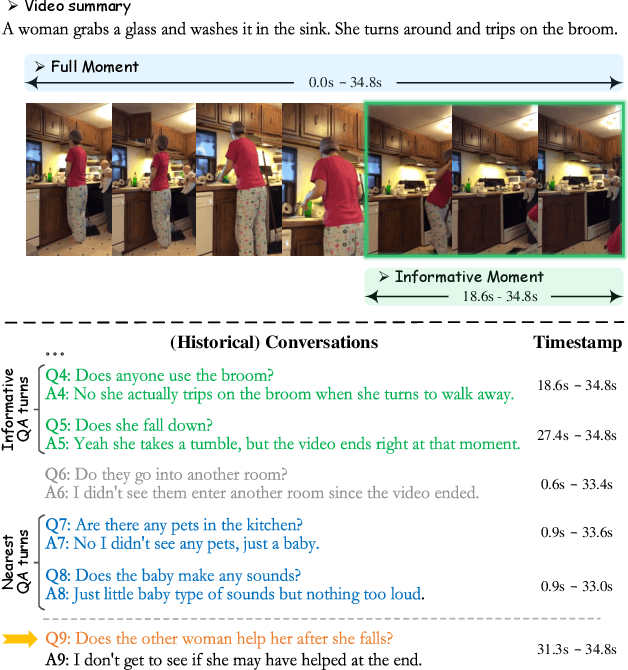

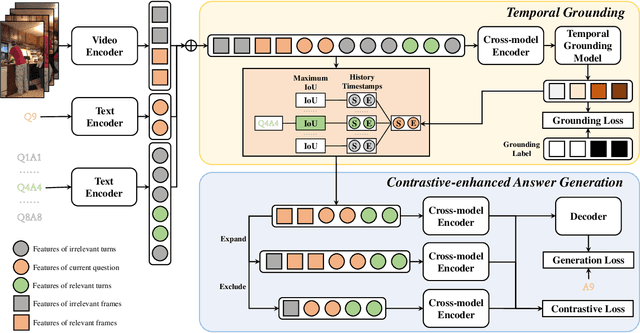

Abstract:In the realm of video dialog response generation, the understanding of video content and the temporal nuances of conversation history are paramount. While a segment of current research leans heavily on large-scale pretrained visual-language models and often overlooks temporal dynamics, another delves deep into spatial-temporal relationships within videos but demands intricate object trajectory pre-extractions and sidelines dialog temporal dynamics. This paper introduces the Dual Temporal Grounding-enhanced Video Dialog model (DTGVD), strategically designed to merge the strengths of both dominant approaches. It emphasizes dual temporal relationships by predicting dialog turn-specific temporal regions, filtering video content accordingly, and grounding responses in both video and dialog contexts. One standout feature of DTGVD is its heightened attention to chronological interplay. By recognizing and acting upon the dependencies between different dialog turns, it captures more nuanced conversational dynamics. To further bolster the alignment between video and dialog temporal dynamics, we've implemented a list-wise contrastive learning strategy. Within this framework, accurately grounded turn-clip pairings are designated as positive samples, while less precise pairings are categorized as negative. This refined classification is then funneled into our holistic end-to-end response generation mechanism. Evaluations using AVSD@DSTC-7 and AVSD@DSTC-8 datasets underscore the superiority of our methodology.
PCQPR: Proactive Conversational Question Planning with Reflection
Oct 02, 2024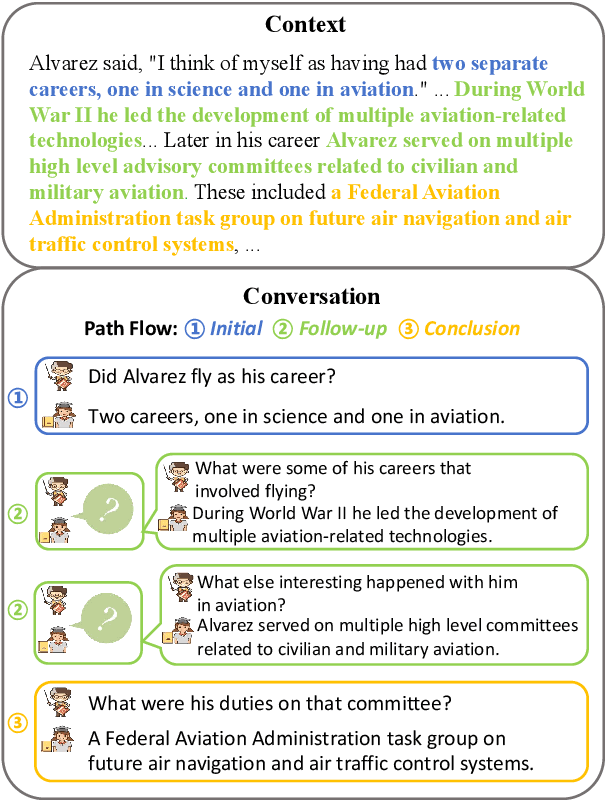
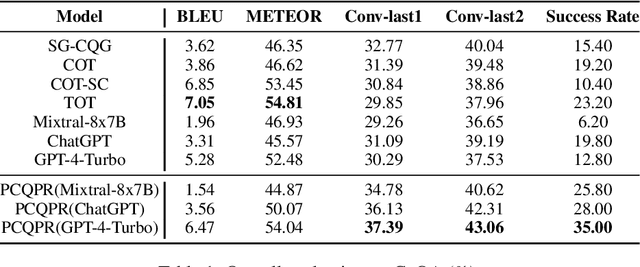
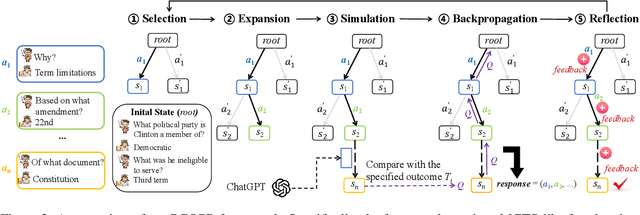
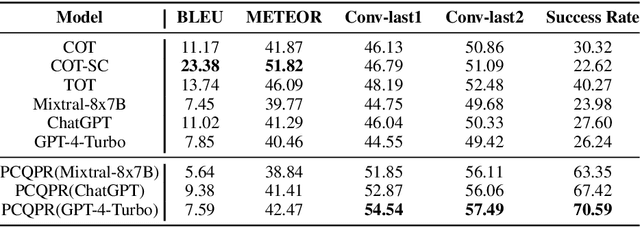
Abstract:Conversational Question Generation (CQG) enhances the interactivity of conversational question-answering systems in fields such as education, customer service, and entertainment. However, traditional CQG, focusing primarily on the immediate context, lacks the conversational foresight necessary to guide conversations toward specified conclusions. This limitation significantly restricts their ability to achieve conclusion-oriented conversational outcomes. In this work, we redefine the CQG task as Conclusion-driven Conversational Question Generation (CCQG) by focusing on proactivity, not merely reacting to the unfolding conversation but actively steering it towards a conclusion-oriented question-answer pair. To address this, we propose a novel approach, called Proactive Conversational Question Planning with self-Refining (PCQPR). Concretely, by integrating a planning algorithm inspired by Monte Carlo Tree Search (MCTS) with the analytical capabilities of large language models (LLMs), PCQPR predicts future conversation turns and continuously refines its questioning strategies. This iterative self-refining mechanism ensures the generation of contextually relevant questions strategically devised to reach a specified outcome. Our extensive evaluations demonstrate that PCQPR significantly surpasses existing CQG methods, marking a paradigm shift towards conclusion-oriented conversational question-answering systems.
* Accepted by EMNLP 2024 Main
Retrieval Augmented Generation for Dynamic Graph Modeling
Aug 26, 2024Abstract:Dynamic graph modeling is crucial for analyzing evolving patterns in various applications. Existing approaches often integrate graph neural networks with temporal modules or redefine dynamic graph modeling as a generative sequence task. However, these methods typically rely on isolated historical contexts of the target nodes from a narrow perspective, neglecting occurrences of similar patterns or relevant cases associated with other nodes. In this work, we introduce the Retrieval-Augmented Generation for Dynamic Graph Modeling (RAG4DyG) framework, which leverages guidance from contextually and temporally analogous examples to broaden the perspective of each node. This approach presents two critical challenges: (1) How to identify and retrieve high-quality demonstrations that are contextually and temporally analogous to dynamic graph samples? (2) How can these demonstrations be effectively integrated to improve dynamic graph modeling? To address these challenges, we propose RAG4DyG, which enriches the understanding of historical contexts by retrieving and learning from contextually and temporally pertinent demonstrations. Specifically, we employ a time- and context-aware contrastive learning module to identify and retrieve relevant cases for each query sequence. Moreover, we design a graph fusion strategy to integrate the retrieved cases, thereby augmenting the inherent historical contexts for improved prediction. Extensive experiments on real-world datasets across different domains demonstrate the effectiveness of RAG4DyG for dynamic graph modeling.
Planning Like Human: A Dual-process Framework for Dialogue Planning
Jun 08, 2024Abstract:In proactive dialogue, the challenge lies not just in generating responses but in steering conversations toward predetermined goals, a task where Large Language Models (LLMs) typically struggle due to their reactive nature. Traditional approaches to enhance dialogue planning in LLMs, ranging from elaborate prompt engineering to the integration of policy networks, either face efficiency issues or deliver suboptimal performance. Inspired by the dualprocess theory in psychology, which identifies two distinct modes of thinking - intuitive (fast) and analytical (slow), we propose the Dual-Process Dialogue Planning (DPDP) framework. DPDP embodies this theory through two complementary planning systems: an instinctive policy model for familiar contexts and a deliberative Monte Carlo Tree Search (MCTS) mechanism for complex, novel scenarios. This dual strategy is further coupled with a novel two-stage training regimen: offline Reinforcement Learning for robust initial policy model formation followed by MCTS-enhanced on-the-fly learning, which ensures a dynamic balance between efficiency and strategic depth. Our empirical evaluations across diverse dialogue tasks affirm DPDP's superiority in achieving both high-quality dialogues and operational efficiency, outpacing existing methods.
Analyzing Temporal Complex Events with Large Language Models? A Benchmark towards Temporal, Long Context Understanding
Jun 04, 2024Abstract:The digital landscape is rapidly evolving with an ever-increasing volume of online news, emphasizing the need for swift and precise analysis of complex events. We refer to the complex events composed of many news articles over an extended period as Temporal Complex Event (TCE). This paper proposes a novel approach using Large Language Models (LLMs) to systematically extract and analyze the event chain within TCE, characterized by their key points and timestamps. We establish a benchmark, named TCELongBench, to evaluate the proficiency of LLMs in handling temporal dynamics and understanding extensive text. This benchmark encompasses three distinct tasks - reading comprehension, temporal sequencing, and future event forecasting. In the experiment, we leverage retrieval-augmented generation (RAG) method and LLMs with long context window to deal with lengthy news articles of TCE. Our findings indicate that models with suitable retrievers exhibit comparable performance with those utilizing long context window.
Towards Human-centered Proactive Conversational Agents
Apr 19, 2024Abstract:Recent research on proactive conversational agents (PCAs) mainly focuses on improving the system's capabilities in anticipating and planning action sequences to accomplish tasks and achieve goals before users articulate their requests. This perspectives paper highlights the importance of moving towards building human-centered PCAs that emphasize human needs and expectations, and that considers ethical and social implications of these agents, rather than solely focusing on technological capabilities. The distinction between a proactive and a reactive system lies in the proactive system's initiative-taking nature. Without thoughtful design, proactive systems risk being perceived as intrusive by human users. We address the issue by establishing a new taxonomy concerning three key dimensions of human-centered PCAs, namely Intelligence, Adaptivity, and Civility. We discuss potential research opportunities and challenges based on this new taxonomy upon the five stages of PCA system construction. This perspectives paper lays a foundation for the emerging area of conversational information retrieval research and paves the way towards advancing human-centered proactive conversational systems.
Multilingual Large Language Model: A Survey of Resources, Taxonomy and Frontiers
Apr 07, 2024Abstract:Multilingual Large Language Models are capable of using powerful Large Language Models to handle and respond to queries in multiple languages, which achieves remarkable success in multilingual natural language processing tasks. Despite these breakthroughs, there still remains a lack of a comprehensive survey to summarize existing approaches and recent developments in this field. To this end, in this paper, we present a thorough review and provide a unified perspective to summarize the recent progress as well as emerging trends in multilingual large language models (MLLMs) literature. The contributions of this paper can be summarized: (1) First survey: to our knowledge, we take the first step and present a thorough review in MLLMs research field according to multi-lingual alignment; (2) New taxonomy: we offer a new and unified perspective to summarize the current progress of MLLMs; (3) New frontiers: we highlight several emerging frontiers and discuss the corresponding challenges; (4) Abundant resources: we collect abundant open-source resources, including relevant papers, data corpora, and leaderboards. We hope our work can provide the community with quick access and spur breakthrough research in MLLMs.
SGSH: Stimulate Large Language Models with Skeleton Heuristics for Knowledge Base Question Generation
Apr 02, 2024
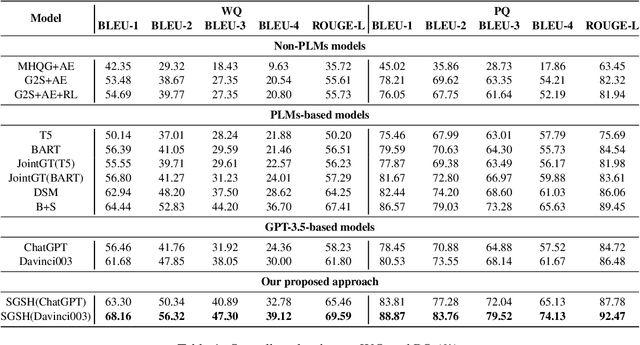
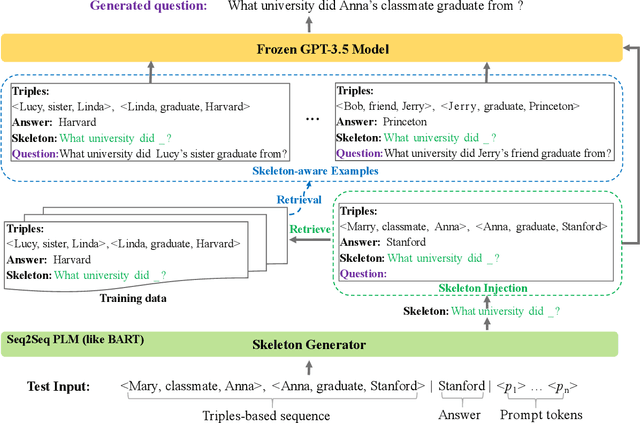
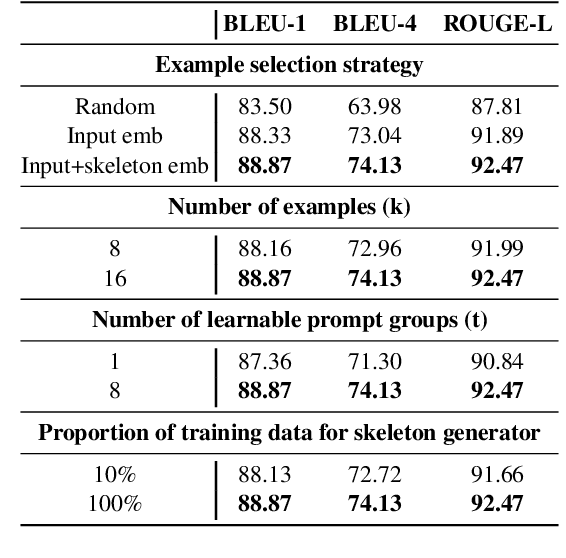
Abstract:Knowledge base question generation (KBQG) aims to generate natural language questions from a set of triplet facts extracted from KB. Existing methods have significantly boosted the performance of KBQG via pre-trained language models (PLMs) thanks to the richly endowed semantic knowledge. With the advance of pre-training techniques, large language models (LLMs) (e.g., GPT-3.5) undoubtedly possess much more semantic knowledge. Therefore, how to effectively organize and exploit the abundant knowledge for KBQG becomes the focus of our study. In this work, we propose SGSH--a simple and effective framework to Stimulate GPT-3.5 with Skeleton Heuristics to enhance KBQG. The framework incorporates "skeleton heuristics", which provides more fine-grained guidance associated with each input to stimulate LLMs to generate optimal questions, encompassing essential elements like the question phrase and the auxiliary verb.More specifically, we devise an automatic data construction strategy leveraging ChatGPT to construct a skeleton training dataset, based on which we employ a soft prompting approach to train a BART model dedicated to generating the skeleton associated with each input. Subsequently, skeleton heuristics are encoded into the prompt to incentivize GPT-3.5 to generate desired questions. Extensive experiments demonstrate that SGSH derives the new state-of-the-art performance on the KBQG tasks.
 Add to Chrome
Add to Chrome Add to Firefox
Add to Firefox Add to Edge
Add to Edge